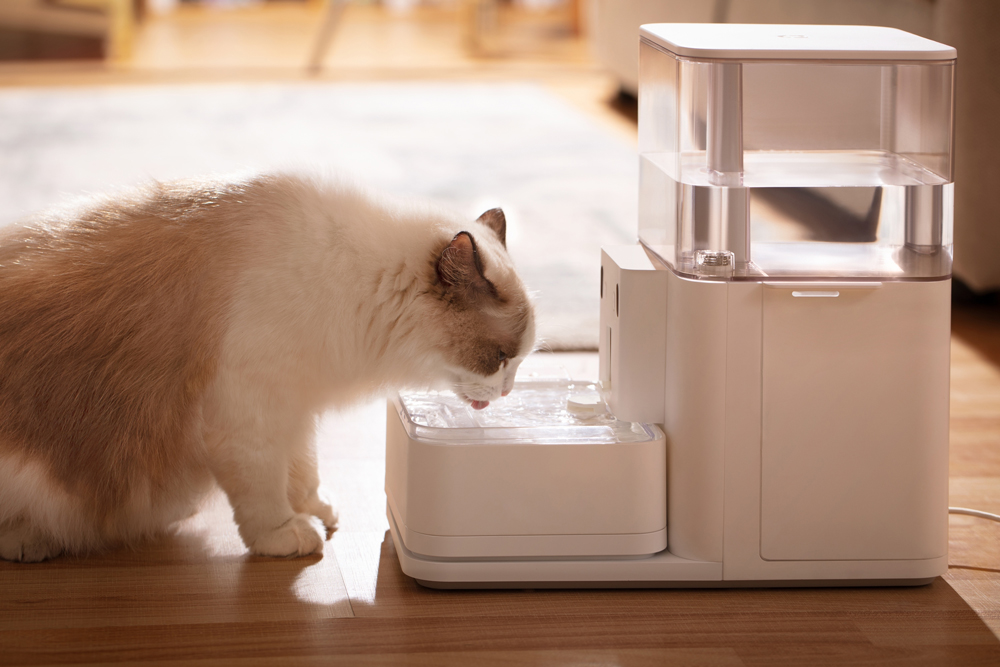By Steve Dale
Depending on where you live, you can expect high temps for at least the next couple of months. That means you need to stay vigilant about protecting pets from heat-related injuries. We tend to think most commonly of dogs in this respect, but cats are at risk of life-threatening heatstroke, too, especially if they are very young, very old, or have respiratory difficulties related to having a flat face or an upper respiratory infection.
Cats are tricky, though. It’s common for them to mask signs of unwellness, including feeling the effects of heat. Here’s what to look for:
· Excess thirst
· Panting
· Wobbly gait
· Confusion
Cats don’t typically drink large amounts of water at once, so unusual thirst on a hot day is a clue. So is panting. That’s a more common behavior in dogs, not cats, and it can signal that the cat is overheated. Walking unsteadily or seeming confused are also red flags for heatstroke.
If you see any of these warnings, keep your cat in a cool (not cold place), take your cat’s temperature (105 degrees or more confirms danger), and contact your veterinarian— fast. If your veterinarian isn’t available, take the cat to the nearest veterinary ER.
High-Rise Syndrome
Heatstroke isn’t the only heat-related injury that affects cats. Increasingly, people allow cats on outdoor high-rise balconies, which is a great idea if the cats have no way out—or off. Cats may see a butterfly or bird go by and take a leap of faith, which rarely ends well. Sometimes they escape by pushing open window screens.
Cats fall from windows or balconies occurs so often that the resulting injury has a name: high-rise syndrome.
It’s true, cats can land on all fours. Domestic cats innately have an ability to right themselves in mid-air as they fall. However, according to the Association for Pet Obesity Prevention, 61 percent of cats are overweight or obese. These cats may no longer have the ability to perform mid-air summersaults. Elderly cats also may also have lost this facility.
Here’s an amazing stat: It is possible for a cat to survive at a velocity of 60 miles per hour, as demonstrated by a study done on 132 cats who fell an average of 5.5 stories,
published in The Journal of the American Veterinary Medical Association. Researchers tabulated the numbers of cats who fell from buildings and were subsequently treated. Of the cats studied, 90 percent survived, although many required significant medical attention. That’s from an average of 5.5 stories, but from 20 floors up, cats are very unlikely to survive.
Even when cats do land on all fours, it doesn’t always go well, as legs are often broken in the process. Commonly, the force pushes their neck and head to keep going until the jaw hits the ground, and broken jaws are not infrequent when cats take a free fall.
For cats falling from low branches on a tree, the equivalent of one or two stories up, it’s close enough to the ground that they may not have time to turn around in midair and land on all fours, which also causes injuries.
In short, while cats have exceptional abilities to deal with falls off balconies, trees, or ledges when compared to dogs or people, injury or death may still occur.
Up a Tree
Cats will climb trees in pursuit of a bird or squirrel, to get away from a coyote or another cat, or sometimes just because they enjoy climbing a tree. However, cats tend to climb trees without a plan to get down.
So, what do you do about those cats up a tree? Shaking them loose and hoping the cat survives the fall or encouraging the cat to dive down are never good ideas!
Call the fire department?
Unless you get Sarah, the Mayberry operator, you’ll likely hear a bemused operator reply, “You’re kidding, right?” If you do somehow persuade emergency personnel to respond, there may be a fee. Barney Fife won’t rescue the cat.
The best advice: Be patient. Veterinary ER clinics rarely report treating cats who have fallen from trees. Emergency rooms do treat people who have fallen trying to rescue feline friends. Entice kitty with tuna, sardines, or salmon at the base of the tree and wait for hunger to overcome fear.
To make sure you’re prepared to face any of these situations and care for your pet in an effective and Fear Free manner, consider taking a pet first aid course so you’ll feel comfortable and knowledgeable when facing a pet emergency.
This article was reviewed/edited by board-certified veterinary behaviorist Dr. Kenneth Martin and/or veterinary technician specialist in behavior Debbie Martin, LVT.
Steve Dale, CABC (certified animal behavior consultant), hosts two national pet radio shows and is on WGN Radio, Chicago. He’s a regular contributor/columnist for many publications, including CATSTER, Veterinary Practice News, and the Journal of the National Association of
Veterinary Technicians in America. He’s appeared on dozens of TV shows, including Oprah, many Animal Planet Programs, and National Geographic Explorer. He has contributed to or authored many pet books and veterinary textbooks such as “The Cat: Clinical Medicine and Management” and co-edited Decoding Your Dog, by the American College of Veterinary Behaviorists. He speaks at conferences around the world. www.stevedale.tv.
Want to learn more about Fear Free? Sign up for our newsletter to stay in the loop on upcoming events, specials, courses, and more by clicking here!








